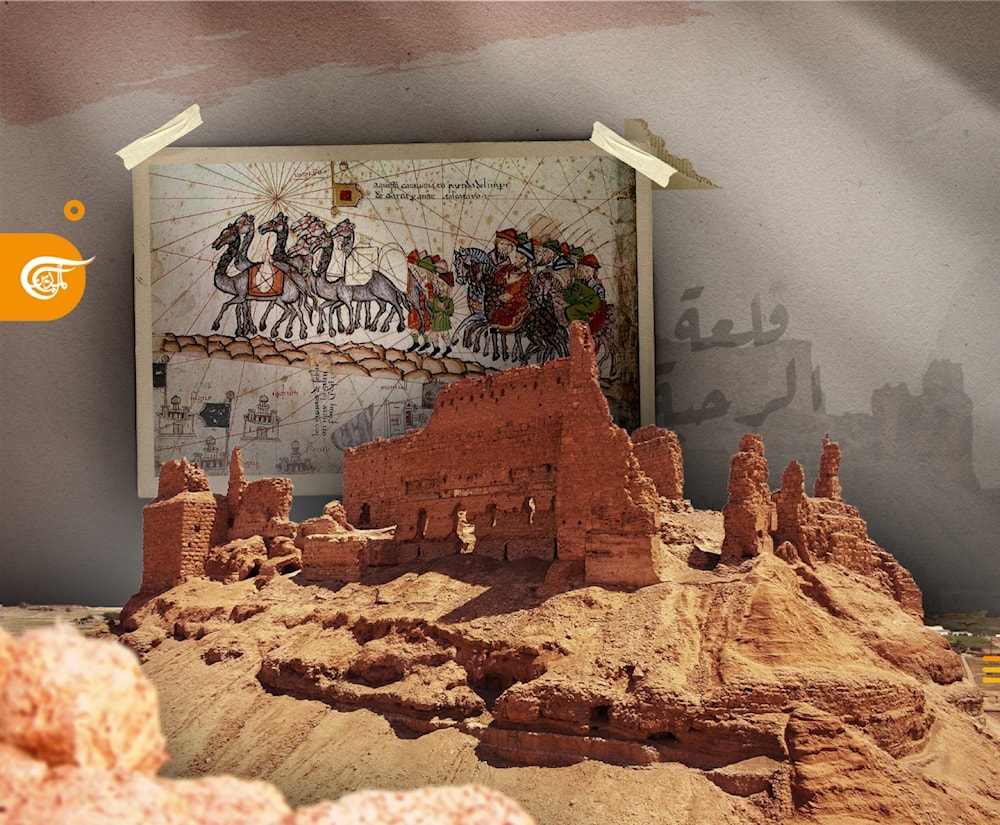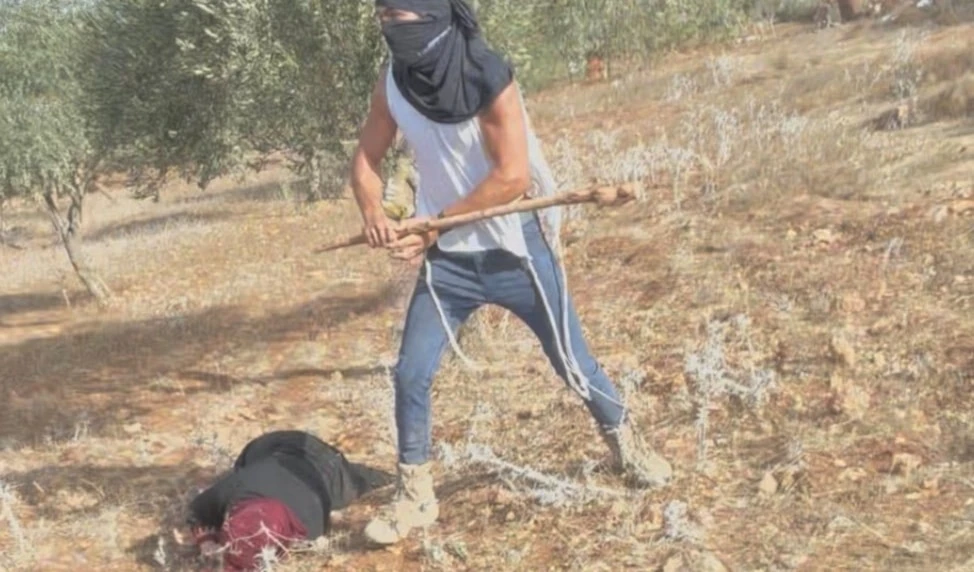Al-Rahba Castle: How the US is destroying Syrian cultural identity
What do you know about al-Rahba Castle, which was recently bombed by American occupation forces?
-

How is the US destroying the historical al-Rahba Castle in Syria? (Al Mayadeen)
On the right bank of the Euphrates in Deir Ezzor village, northwest of Syria, the town of al-Mayadin is surrounded by a fertile agricultural plain. Adjacent to the unique archeological hill, al-Rahba, and above the hills looms al-Rahba Castle, constructed in the second century BC by the Aramean King Ninus Ibn Belus.
The fortress stood as one of the most important trade stations on the Silk Road and one of the most important archaeological sites in the Syrian part of Upper Mesopotamia, also known as al-Jazira.
Al-Rahba embodies the key characteristics of impregnable castles built upon the foundations of military engineering during that era. Its structure consists of three floors and two internal and external walls. The length of the external wall stretches for 274 meters while the internal wall’s length is 137 meters. The name of the castle, al-Rahba, signifies its spacious qualities.
Its proximity to the Euphrates River has awarded the fortress a strategic geographical location, granting it a crucial historical role during the Middle Ages. Several pivotal events that altered the course of Islamic history took place on its grounds. Al-Rahba’s location granted it economic, agricultural, and commercial wealth, as it overlooks a wide plain irrigated by the Euphrates River. Its fertile location attracted numerous Arab tribes to live in its vicinity over the past centuries.
Strategic location on Silk Road
The Castle is situated in a distinguished strategic location and is considered Iraq’s gateway to the Levant and the latter's access point to Mesopotamia. Historians have for hundreds of years recognized it as one of the most crucial trade stations on the ancient Silk Road, which extends from China to Europe and vice versa.
Al-Rahba was constructed on a high and isolated rocky plateau, rising 230 meters above sea level. It overlooks a deep valley approximately 20 meters wide overlooking a network of vital commercial and military routes that lead to Aleppo, Baghdad, Damascus, Palmyra, and Mosul. Situated at the end of a valley and perched high above it, the castle overlooks both the valley and a water swamp. This embodies the meaning of the name "Al-Rahba", as al-Rihab (plural of Rahba) refers to areas in the valleys, harmoniously integrated with the surrounding water swamp in and around it.
Al-Rahba Fortress is encircled by an outer wall built with large stones and tiles, comprising five sides, with the longest facing the southern side overlooking the Syrian desert. Its main entrance is located on the northwest side. Another wall was built with large stones and features five sides, with the longest being the western one, which encircles the fortress built in the seventh century AH.
Within al-Rahba Castle, there are three lower floors. The first floor includes halls, rooms, and warehouses, while the second floor is slightly smaller in size. The third floor houses a large hall that served as the primary warehouse for the Castle's operators. The main entrance to the castle is positioned on the western side of the outer wall, leading into a domed corridor with a 5-meter high ceiling. This corridor extends into the inner sections of the castle and to the guards' room. Throughout the Castle, one can find various rooms, spacious warehouses, and brick arches supported by two rows resting on the foundations of the inner wall.
Ibrahim al-Rawi, Director of Culture in Deir Ezzor, affirmed in an interview for Al Mayadeen, the cultural page, that studies have revealed that the citadel was not constructed over a single period of time, but rather its building and restoration occurred over multiple periods. Initially, the Castle was constructed using bricks, and a moat was excavated around it. Subsequently, during the second phase, segments of the Castle were constructed with large, intricately carved stones. In the third phase, the Castle underwent expansion, which included additional towers and an inner fort. During the fourth phase, enhancements were made to raise the outer walls, using relatively small stones. Moreover, retaining walls were added for structural support, and residential houses were incorporated into the structure, dating back to the Ottoman period.
Al-Rawi delves deeper into the intricate web of historical debate, pointing to the discord and controversy enveloping the enigmatic figure credited with the Castle's inception. While some references suggest that the ancient structure dates back to the Aramean or Amorite period, others attribute its construction to Malik ibn Tawk. A third opinion suggests that Asad al-Din Shirkuh was likely the builder, while a fourth opinion attributes it to Shirkuh bin Nasser al-Din.
Al-Rawi highlights that the history of the castle can be traced back to 2500 BC when it was first inhabited by the Arameans, followed by the Amorites, Arabs, and Seljuks. It rose to prominence as the center of a thriving city on the banks of the Euphrates River during the Abbasid era, reaching its peak of prosperity during the Ayyubid period.
The Director of Culture in Deir Ezzor confirmed the assessment of the strategic position of the castle, emphasizing the importance of the deep valley that encircles it, as well as the fact that it was built on an isolated rocky plateau that rises 230 meters above sea level. He reiterated that its position privileged it with a strategic overlook over one of the world's most traversed trade routes, the Silk Road.
Read more: Al Mayadeen Net follows up on the Turkish mafias' theft of Syrian antiquities
Al-Rahba's archeological significance and US attacks
Throughout its extensive history, the Castle endured numerous wars, attacks, and efforts to erase its identity, resulting in partial destruction on multiple occasions. The most recent attack occurred during the US aggression on the Syrian-Iraqi border in early February 2024. This strike was allegedly a response to an attack on the secret American "Tower 22" base in Jordan, which resulted in the death of three soldiers and the injury of thirty-four others. One of the raids targeted the vicinity of al-Rahba Castle.
The US occupation forces' bombing campaign caused significant damage to the citadel's structure, resulting in cracks and fissures in its walls. In response, the Syrian Ministry of Culture condemned "the barbaric American bombing of the ancient al-Rahba Citadel," denouncing it as a violation of international norms and conventions that advocate for the protection and respect of cultural heritage during armed conflicts.
Researcher Abdel Moneim Khalil asserts that the recent American bombing of the citadel is one of many attacks that the structure has endured throughout its history. Being one of the distinctive monuments in Deir Ezzor Governorate, the citadel holds significant historical value. Khalil suggests that the United States has consistently aimed to erase the historical and national identity of Syrian landmarks, which bear witness to the region's rich civilization.
Khalil disclosed in an interview for Al Mayadeen that al-Rahba Castle has also faced repeated attacks from armed factions that gained control of the Deir Ezzor's countryside in 2011. These militants looted the Castle's contents and conducted extensive excavations around it in search of archaeological treasures. The plundered artifacts were then smuggled to Iraq or Turkey and eventually sold in Europe. Given that the Syrian al-Jazira region is renowned for its rich antiquities, it became a prime target for these armed factions seeking to profit from the illicit trade of cultural heritage.
The Castle has been intertwined with the history of the Syrian Island, situated in the far northeast of the country. Across its storied past, al-Rahba stands witness to numerous battles and victories significant in Arab and Islamic history. It has also nurtured a strong bond with the al-Jazira community and its inhabitants, who view the castle as an inseparable part of their identity.
Thus, Saleh al-Mahmoud al-Duwaihi, a resident of al-Mayadin town in the Deir Ezzor countryside, expresses profound concern about the repercussions of American aggression on the citadel.
"We were deeply saddened to witness the ancient al-Rahba Castle come under American attack. The Castle not only holds archaeological significance but also serves as an existential and social symbol deeply connected to the area’s inhabitants for hundreds of years. Each individual has a cherished memory associated with it. The Castle, its serene surroundings, and the encompassing hills were once a gathering place and a haven for the people before the war. It was a popular destination for tourists seeking to admire the beauty of Syrian civilization and the breathtaking desert landscape, particularly during the spring season when flowers and wild herbs covered the area," al-Duwahi said.
Read more: Battle for existence: How normalization endangers Arab heritage

 8 Min Read
8 Min Read










